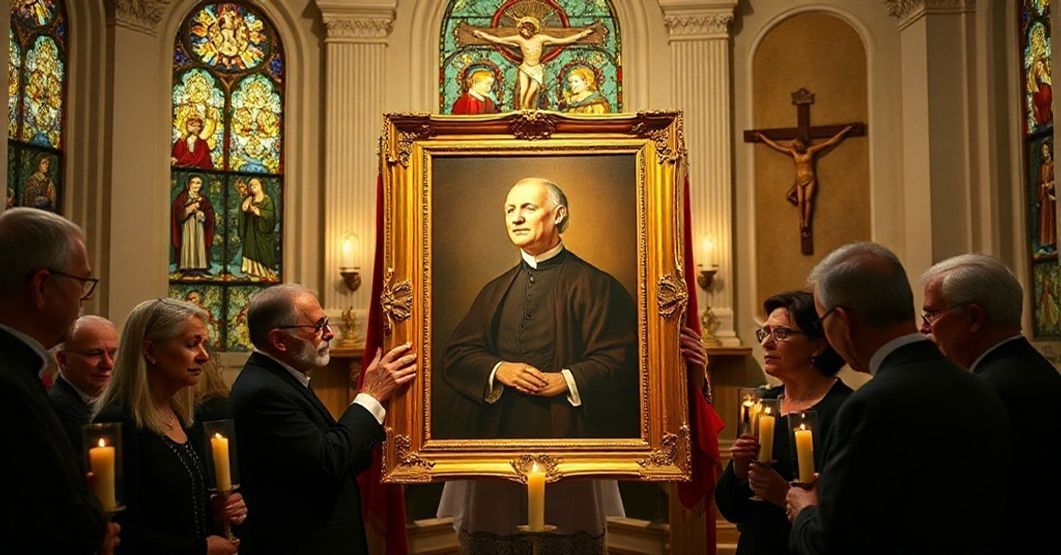Newman’s Heretical Legacy: A Masonic “Doctor” of the Neo-Church
Newman’s Heretical Legacy: A Masonic “Doctor” of the Neo-Church
Portal Catholic News Agency (November 2, 2025) reports the conciliar sect’s announcement declaring Anglican convert John Henry Newman a “doctor of the Church.” The article describes Newman as a “respected Anglican priest” who later contributed to Catholic teaching through his “keen insight into modern times,” with Bergoglio’s 2019 “canonization” cited as validating his “holiness.” The text defines a “doctor of the Church” as requiring canonization, theological eminence, and papal declaration – claiming Newman meets these through his 40 books and letters. The report lists other post-1958 “doctors” like Irenaeus of Lyon and Gregory of Narek, ignoring their doctrinal deviations.
Doctrinal Subversion Masquerading as Development
The article’s praise of Newman’s “insight into modern times” exposes the conciliar sect’s foundational error: scientia inflat (knowledge puffs up – 1 Cor 8:1). Newman’s chief heresy – the evolutionary conception of dogma – directly contradicts Pope St. Pius X’s condemnation in Lamentabili Sane (1907), which anathematized the proposition that “Christian doctrine was initially Jewish, but through gradual development, it became first Pauline, then Johannine, and finally Greek and universal” (Proposition 60). Newman’s Essay on the Development of Christian Doctrine (1845) explicitly promotes this condemned thesis, arguing doctrines “develop” rather than being “once delivered to the saints” (Jude 1:3).
Pope St. Pius X’s encyclical Pascendi Dominici Gregis (1907) identifies such theories as Modernism’s essence: “They affirm that religious formulas… are to be reduced to the minimum. In the past, they say, they were more abundant; now they must be made more sparse.” Newman’s Anglican past isn’t a credential but a disqualification – the Council of Trent (Session 23, Chapter 4) declares holy orders outside the Church “null and void,” making his Anglican “priesthood” sacrilegious mimicry.
Illegitimate Proclamation by Usurped Authority
The article treats Bergoglio’s 2019 “canonization” and Prevost’s (“Leo XIV”) declaration as valid, ignoring the de fide teaching that heretics cannot hold papal office (St. Robert Bellarmine, De Romano Pontifice II.30). Pius XII’s Vacantis Apostolicae Sedis (1945) confirms that during sede vacante, no one may modify Church discipline. Since Angelo Roncalli’s (“John XXIII”) election violated Pope Pius XII’s conclave procedures (e.g., admitting non-cardinals), all subsequent “popes” are antipopes. Thus, Newman’s “doctorate” proclamation lacks authority, as the conciliar sect possesses no jurisdiction.
The article’s claim that doctors need only “significant contributions” ignores the Church’s immutable criteria: sanctitas vitae (holiness of life), eminentia doctrinae (eminence in doctrine), and ecclesiae declaratio (ecclesiastical declaration). Newman fails all three:
- His deathbed refusal to renounce evolutionary dogma demonstrates defective sanctity.
- His writings promote indifferentism, claiming “many religions may be from God” (Apologia Pro Vita Sua, 1864).
- True declarations require a valid pope – absent since 1958.
Ecumenism’s Trojan Horse
By celebrating Newman’s Anglican past, the article promotes the heresy of religious indifferentism condemned by Pope Pius IX in Syllabus Errorum (1864): “Good hope at least is to be entertained of the eternal salvation of all those who are not at all in the true Church of Christ” (Proposition 17). Newman’s famous toast – “to conscience first, to the pope afterwards” – inverts St. Paul’s “non enim judicavi me scire aliquid inter vos, nisi Jesum Christum, et hunc crucifixum” (For I decided to know nothing among you except Jesus Christ and him crucified – 1 Cor 2:2).
Worse, Newman’s burial alongside Fr. Ambrose St. John – interpreted by historians like Ian Ker as evidence of homosexual attachment – mocks the Church’s teaching on scandal (Matt 18:6). The conciliar sect’s silence on this confirms its apostasy from Catholic morals.
Theological Contradictions Exposed
Newman’s most dangerous error – the “illative sense” theory – reduces faith to probabilistic reasoning, condemned by Pope St. Pius X as Modernist agnosticism: “Faith, as assent of the mind, is ultimately based on a sum of probabilities” (Lamentabili Sane, Proposition 25). Contrast this with St. Thomas Aquinas: “Credere est assentire propter auctoritatem Dei loquentis” (To believe is to assent because of God’s authority – Summa Theologiae II-II, q.2, a.9).
The article’s inclusion of Thérèse of Lisieux among “doctors” further reveals the neo-church’s bankruptcy. The Little Flower’s doctrine of spiritual childhood presupposes immutable dogma, writing: “I do not desire visions or revelations… I prefer to wait for eternal truth” (Story of a Soul, 1898). Newman’s evolutionary model destroys this childlike faith, making him not a doctor but a destroyer of the Church.
Conclusion: Rejecting the Conciliar Counterfeit
As St. Vincent of Lérins taught in Commonitorium (434 AD), true doctrine develops “eodem sensu eademque sententia” (in the same sense and meaning). Newman’s theories – now enshrined by the conciliar sect – justify Vatican II’s apostasies: religious liberty (Dignitatis Humanae), collegiality (Lumen Gentium), and ecumenism (Unitatis Redintegratio). Catholics must reject this pseudo-doctorate, clinging to the Church’s true doctors: Athanasius contra mundum, Augustine against Pelagius, Pius X crushing Modernism. Let the faithful echo St. Paul: “Si quis vobis evangelizaverit praeter id quod accepistis, anathema sit!” (If anyone preaches a gospel contrary to what you received, let him be anathema! – Gal 1:9).
Source::
CNA explains: What does it mean to be a doctor of the Church? (catholicnewsagency.com)
Article date: 02.11.2025
